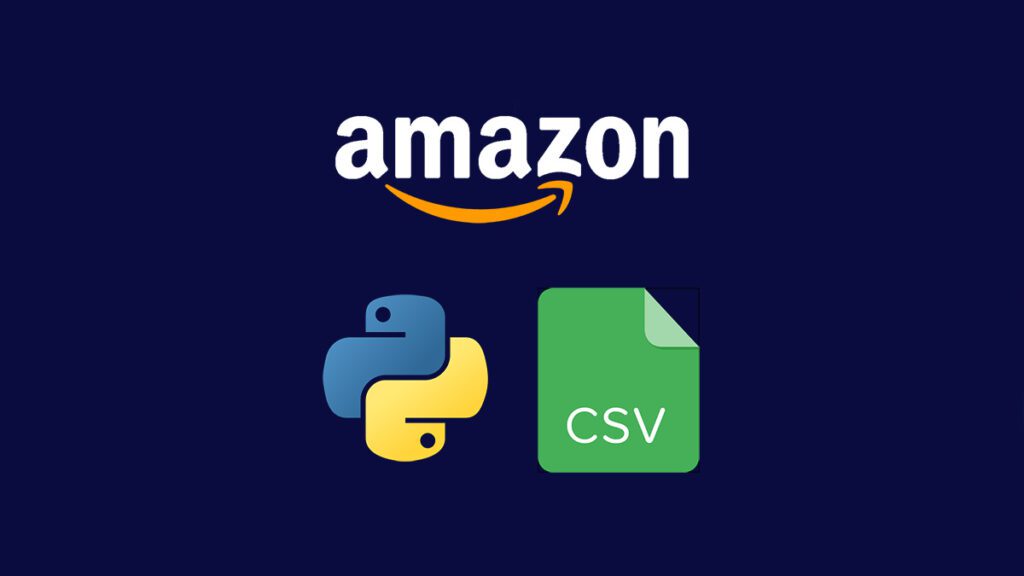Introduction
The Importance of Web Crawlers
Web crawlers are automated tools designed to collect large amounts of data from the internet. They play a crucial role in search engines, market analysis, data mining, and more. Web crawlers not only save time and cost of manual operations but also efficiently gather the latest information.
Commercial Value of Amazon Data Scraping
As the world’s largest online retail platform, Amazon holds a vast amount of product data. This data is extremely valuable for market research, competitive analysis, product optimization, and more. By scraping Amazon data, businesses can obtain key information such as prices, stock levels, and customer reviews, helping them to formulate more effective business strategies.
Purpose of This Article and Expected Benefits for Readers
This article aims to introduce how to perform Amazon data scraping using Python, providing a detailed guide from environment setup, crawler development, to data storage. Readers will learn the basic techniques of using APIs and web crawlers, methods to handle dynamically loaded content and anti-crawling mechanisms, and understand the advantages of using the Pangolin Scrape API.
Environment Setup and Preparation
Installing and Configuring the Python Environment
First, you need to install Python on your computer. Python 3.8 or higher is recommended to ensure compatibility with the latest library versions. You can download the appropriate installer for your operating system from the official Python website.
Note: Ensure Compatibility Between Python Version and Libraries
When installing Python, make sure the selected version is compatible with the libraries you will use. Some libraries may not support the latest Python versions, so check the relevant documentation before installation.
Necessary Python Library Installation
To implement web crawler functionality, you need to install the following Python libraries:
requests: for sending HTTP requestsBeautifulSoup: for parsing HTML documentslxml: a faster parser
Installation Example Code
pip install requests beautifulsoup4 lxml
Basics of Writing a Python Crawler
Defining the Crawler’s Goal and Scope
Before writing a crawler, you need to clearly define the target and scope of the scraping. For example, you might define scraping all product information under a certain category or the detailed information of a specific product.
Request and Response Handling
Sending GET Requests
Use the requests library to send HTTP GET requests to obtain webpage content.
import requests
url = "https://www.amazon.com/s?k=laptop"
response = requests.get(url)
Checking the Response Status Code
Ensure the request is successful and handle possible errors.
if response.status_code == 200:
print("Request successful")
else:
print(f"Request failed with status code {response.status_code}")
Exception Handling
Network Request Exceptions
Handle network connection errors that may occur during the request process.
try:
response = requests.get(url)
response.raise_for_status()
except requests.exceptions.RequestException as e:
print(f"Network error: {e}")
Data Parsing Exceptions
Handle parsing errors that may occur while parsing HTML.
from bs4 import BeautifulSoup
try:
soup = BeautifulSoup(response.text, 'lxml')
except Exception as e:
print(f"Parsing error: {e}")
Scraping Data from Amazon
Step One: Analyzing the Amazon Page Structure
Using Browser Developer Tools
Use the browser’s developer tools (F12) to view the webpage’s HTML structure and determine the HTML elements where the data is located. For example, you can check the tags where the product name, price, etc., are located.
Locating Data in HTML Elements
Based on the page structure, locate the HTML elements containing the required data. For example, the product name might be in a <span class="a-size-medium a-color-base a-text-normal"> tag.
Step Two: Writing the Crawler Logic
Constructing the Request URL
Construct the request URL based on the content you want to scrape. For example, the URL for searching the keyword “laptop” is https://www.amazon.com/s?k=laptop.
Looping Through Pagination
If you need to scrape data from multiple pages, you can loop through the pagination URLs.
for page in range(1, 6):
url = f"https://www.amazon.com/s?k=laptop&page={page}"
response = requests.get(url)
# Process the response content
Selective Data Scraping
Scrape specific data as needed, such as only scraping product names and prices.
Step Three: Data Parsing and Storage
Parsing HTML with BeautifulSoup
Parse the response’s HTML content using BeautifulSoup.
soup = BeautifulSoup(response.text, 'lxml')
Extracting the Required Data
Extract the required data based on the located HTML elements.
titles = soup.find_all('span', class_='a-size-medium a-color-base a-text-normal')
prices = soup.find_all('span', class_='a-offscreen')
for title, price in zip(titles, prices):
print(f"Product: {title.text}, Price: {price.text}")
Storing Data to File or Database
Store the extracted data to a file or database for subsequent analysis.
import csv
with open('amazon_products.csv', 'w', newline='', encoding='utf-8') as file:
writer = csv.writer(file)
writer.writerow(['Product', 'Price'])
for title, price in zip(titles, prices):
writer.writerow([title.text, price.text])
Example Code
Here is a simple example of scraping Amazon product information:
import requests
from bs4 import BeautifulSoup
url = "https://www.amazon.com/s?k=laptop"
response = requests.get(url)
soup = BeautifulSoup(response.text, 'lxml')
titles = soup.find_all('span', class_='a-size-medium a-color-base a-text-normal')
prices = soup.find_all('span', class_='a-offscreen')
with open('amazon_products.csv', 'w', newline='', encoding='utf-8') as file:
writer = csv.writer(file)
writer.writerow(['Product', 'Price'])
for title, price in zip(titles, prices):
writer.writerow([title.text, price.text])
Challenges and Breakthroughs in Crawling
Handling Dynamically Loaded Content
Some content on Amazon pages is loaded dynamically via JavaScript, which traditional HTTP requests cannot retrieve. In such cases, tools like Selenium or Pyppeteer can be used to simulate browser operations.
Using Selenium or Pyppeteer
Selenium Example:
from selenium import webdriver
driver = webdriver.Chrome()
driver.get('https://www.amazon.com/s?k=laptop')
html = driver.page_source
soup = BeautifulSoup(html, 'lxml')
driver.quit()
Dealing with Anti-Crawling Mechanisms
Amazon has robust anti-crawling mechanisms, which require countermeasures to bypass.
Using Proxy IPs
Using proxy IPs can effectively avoid being blocked.
proxies = {
"http": "http://10.10.1.10:3128",
"https": "http://10.10.1.10:1080",
}
response = requests.get(url, proxies=proxies)
Spoofing User-Agent
Spoofing the User-Agent to simulate normal user behavior.
headers = {
"User-Agent": "Mozilla/5.0 (Windows NT 10.0; Win64; x64) AppleWebKit/537.36 (KHTML, like Gecko) Chrome/91.0.4472.124 Safari/537.36"
}
response = requests.get(url, headers=headers)
Delaying Requests to Simulate Normal User Behavior
Add delays to avoid frequent requests leading to being blocked.
import time
for page in range(1, 6):
url = f"https://www.amazon.com/s?k=laptop&page={page}"
response = requests.get(url, headers=headers)
time.sleep(5) # Delay for 5 seconds
Risk Analysis of Scraping Amazon Data
Legal Risks
Scraping Amazon data may involve legal risks, especially when violating terms of service. You need to understand the relevant laws and regulations and ensure that the crawling behavior is legal and compliant.
Account Risks
Frequent scraping may lead to account bans. Avoid using real accounts for scraping or use multiple accounts to distribute the request load.
Data Accuracy Issues
The scraped data may be inaccurate or incomplete, requiring data cleaning and validation.
A Better Choice: Pangolin Scrape API
Features of Pangolin Scrape API
Pangolin Scrape API is a high-efficiency data scraping service designed for scraping Amazon data, with the following features:
Advantages of Specified Postal Area Collection
Allows data collection based on specified postal areas, obtaining more accurate geographic information.
Convenience of SP Ad Collection
Supports the collection of SP ad data for ad performance analysis.
Real-time Data Acquisition for Bestsellers and New Releases
Allows real-time acquisition of bestseller and new release data, helping to understand market trends timely.
Targeted Collection by Keywords or ASIN
Supports targeted collection of data based on keywords or ASIN, obtaining more specific information.
Advantages of Pangolin Scrape API
High-Performance Data Scraping
Pangolin Scrape API has high-performance scraping capabilities, quickly acquiring large amounts of data.
Easy Integration into Existing Systems
The API interface is simple and easy to use, making it easy to integrate into existing systems.
Flexible Data Customization Options
Offers various data customization options to obtain different types of data according to needs.
Conclusion
Through this article, readers have learned how to perform Amazon data scraping using Python, including environment setup, crawler development, and data storage. The methods to handle anti-crawling mechanisms and the advantages of using the Pangolin Scrape API were also introduced.
Using APIs for data scraping can improve efficiency and avoid legal and account risks. The Pangolin Scrape API offers flexible and efficient data scraping services, making it a better choice for scraping Amazon data.
Notes
Ensure Compliance with Amazon’s Terms of Use
When scraping data, ensure compliance with Amazon’s terms of use to avoid legal issues.
Respect Data Privacy and Copyright
Respect data privacy and copyright, and do not use the scraped data for illegal purposes.






